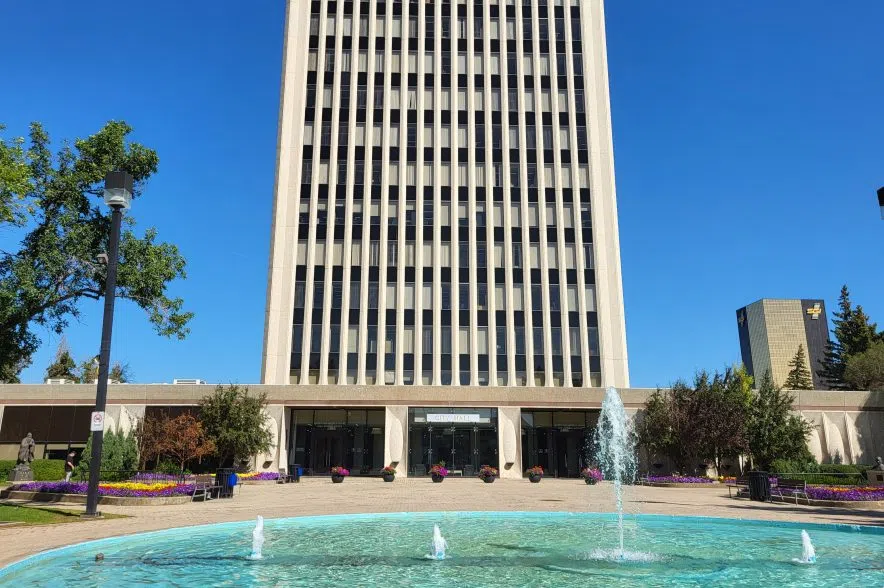Regina City Council got an early look at the city’s projected capital costs for 2026-27, and administration is expecting a shortfall.
The early look at the numbers came as part of a series of special council meetings that are meant to give council and the public more insight into how the city’s proposed budgets are drafted.
Read more:
- Uncertainty around REAL makes booking live events challenging: CEO
- Regina may remove financial hurdles for replacing lead pipes
- Regina City Council approves new costs for Indoor Aquatic Facility
According to a report, the City of Regina is forecasting a $59.26 million funding shortfall on its $244.79 million target for 2026 and a $6.43 million shortfall on its $222.36 million target for 2027.
The numbers are preliminary estimates for the hypothetical costs, and don’t count as actual budget requests.
When asked by Ward 3 Coun. David Froh to explain the gap, chief financial officer Daren Anderson said the shortfalls are a natural part of budgeting, whether in the private sector or government.
“We’re doing all these master plans, and in a vacuum we create a path forward, and it’s hard in the moment to relate that back to the overall plan,” Anderson said during the meeting.
“The complexities of the city as a whole really come together at budget time.”
Anderson said these sorts of issues get hammered out through strategy building and assessing things at budget time.
“You go ‘OK, the fiscal capacity isn’t there to do everything, so now how do we decide the timing of all the things on the wishlist?’” he said.
“I wouldn’t say it’s a funding shortfall. Obviously, if we could fund everything, that would be great,” Anderson said.
Anderson said this year’s funding gap wasn’t out of line with what administration has estimated in previous years.
Jim Nicol, Regina’s acting city manager, said budgeting in the municipal sector is especially challenging.
“Everybody understands that we have limited funds. The reality of the situation is that the public – and I say respectfully, to some extent, council members – have an insatiable appetite to have new things, and things cost money, and everybody thinks that we can just find it,” Nicol said.
“We have a funding shortfall because the desires, expectations and demands of the public, on through to the members of council, keep growing. I’m not here to debate, but nobody runs on ‘I’m going to raise taxes 20 per cent.’ Most people don’t find themselves sitting around the horseshoe.”
Nicol said the new budgeting process allows councillors and the public to transparently see how much it costs to run the city, while managing the demands and expectations of the public.
Mayor Chad Bachynski asked administration to give a high-level overview of the prioritization of different types capital projects, based on criteria set by the firm Colliers Project Leaders.
Administration said those criteria include projects required by legislation, strategic alignment and council-directed service area/master plan priorities, balancing asset management growth, the availability of external funding and additional potential criteria around risk management and safety.
Tuesday’s meeting was the fourth of the five scheduled special meetings ahead of the budget.
None of the meetings featured formal budget requests from administration or organizations like the Regina Police Service or the Regina Exhibition Association Ltd.
Some of the capital investments needing support from the general revenue fund include:
- the Vision Zero road safety plan ($1.15 million in 2026 and $2.84 million in 2027);
- roadways ($49.54 million in 2026 and $41.88 million);
- facilities ($44.05 million in 2026 and $25.67 million in 2027); and
- sustainable infrastructure ($32.49 million in 2026 and $26.74 million in 2027).
Roads
Ward 6 Coun. Victoria Flores asked administration to explain the process for deciding which streets get priority for repairs, saying it’s a concern many residents have spoken to her about.
Administration explained that the city looks at nearby infrastructure, both above and below ground, as well as development that might be happening in the area before making a decision.
The city also takes into consideration where construction is happening and how to avoid having too much construction concentrated in a single area at once.











